Karen Ohanyan’s “Real Utopias”
Gohar Vardanyan
From May 5-31, 2006, Karen Ohanyan’s “Real Utopias” exhibition was heldin one of the contemporary art museums called ACCEA (Armenian Center for Contemporary Experimental Art). In the accompanying textof the exhibition the curator and art critic Vardan Azatyan presented the author using the formal-structural and social analysis of his works. Through the example of comparison with the surrealist works and through the Jack Lacan’s psychoanalysis, this article attempts to reveal the fact of mirror reflection in Ohanyan’s works, and, as a result,it tries toformally bring out some particular details of these works.
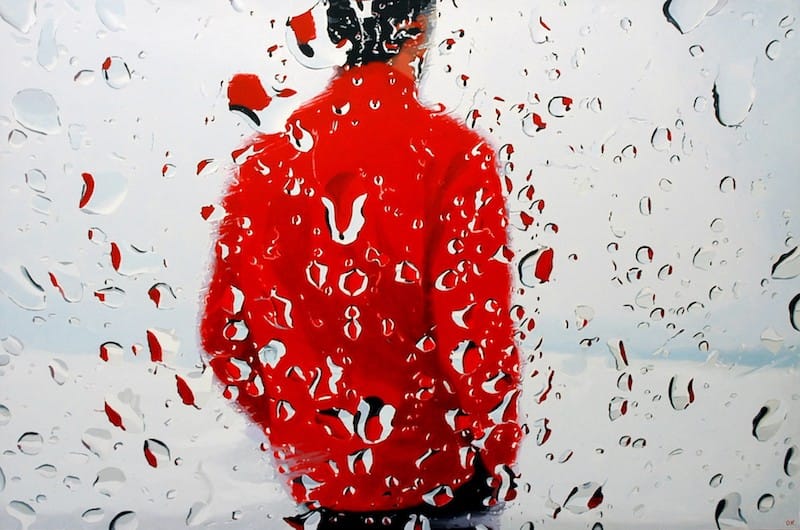 The issue of reflection in Ohanyan’s works is peculiar in a sense that
it’s not possible to observe any essential detail allowing us to think
about the priority of such matter. This fact reminds a unique game where
the problem of mirror reflection can challenge the interpretation of the
interpreter. And if we try to approach to this problem with a more
“scrupulous” eye, we will face two very important types of reflection
existing in “Real Utopias”.
The issue of reflection in Ohanyan’s works is peculiar in a sense that
it’s not possible to observe any essential detail allowing us to think
about the priority of such matter. This fact reminds a unique game where
the problem of mirror reflection can challenge the interpretation of the
interpreter. And if we try to approach to this problem with a more
“scrupulous” eye, we will face two very important types of reflection
existing in “Real Utopias”.
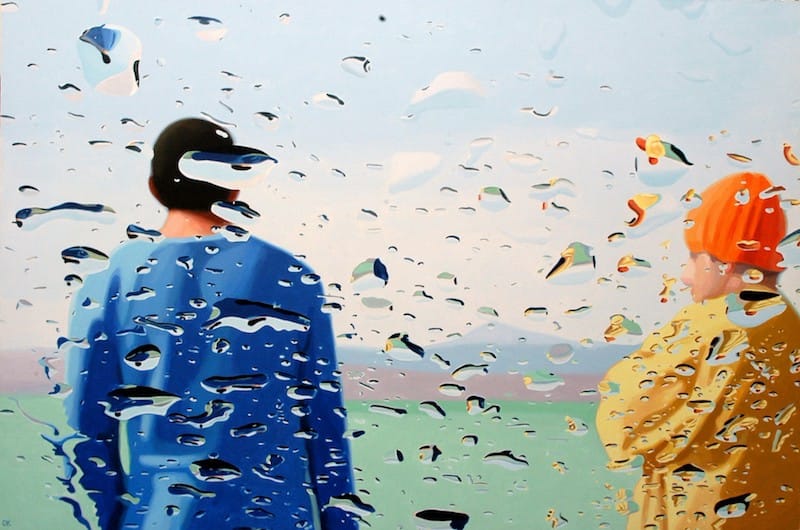 First let’s start from the water drops scattered all over the painting’s
surface, thus creating a transit field between the viewer and the depicted
figure and by this projecting the viewer’s gaze simultaneously to the
inside and outside of the painting. Obtaining the function of bilateral
mirror, (where the other side of reflection is invisible) these “mirrors”,
as opposed to real mirror, do not function like that and reflect the
figure not entirely but part by part. In their spatial perception and in
their inclusion of the space the reflective function of these drops is
surely decreases, because only in the drops of the central part it is
possible to observe complete reflection of the figure. Interestingly,
these mirror-drops, obtaining the quality of convex mirror, reflect the
figure upside-down. Basically, without even fulfilling the undertaken
function, they provide a wrong, or more precisely, a deformed reflection.
The latter fact raises the problem of a surreal relationship between the
real and unreal.
First let’s start from the water drops scattered all over the painting’s
surface, thus creating a transit field between the viewer and the depicted
figure and by this projecting the viewer’s gaze simultaneously to the
inside and outside of the painting. Obtaining the function of bilateral
mirror, (where the other side of reflection is invisible) these “mirrors”,
as opposed to real mirror, do not function like that and reflect the
figure not entirely but part by part. In their spatial perception and in
their inclusion of the space the reflective function of these drops is
surely decreases, because only in the drops of the central part it is
possible to observe complete reflection of the figure. Interestingly,
these mirror-drops, obtaining the quality of convex mirror, reflect the
figure upside-down. Basically, without even fulfilling the undertaken
function, they provide a wrong, or more precisely, a deformed reflection.
The latter fact raises the problem of a surreal relationship between the
real and unreal.
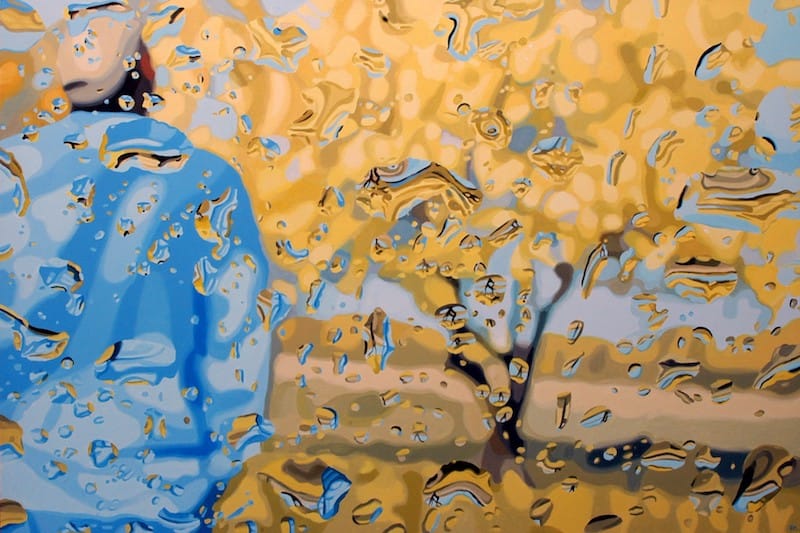 Besides, as Vardan Azatyan mentions, by their reflectionthese mirror-drops
reproduce the same figure on the same figure by not only turning it 180
degrees upside-down but also by multiplying it (however Azatyan is not
going so much deeper into the analysis of the last phenomenon). As a
result of such multiplication, the figure reproduces itself on its own
surface and simultaneously changes its position. In this case it’s
possible to observe some implications with the work of René Magritte.
“Dangerous Liaisons” (1926). Here the reflection of the nude girl who
holds a mirror is seen from the opposite side. As a result the body
represents itself simultaneously from both sides, something which is
impossible to create on a two-dimensional space but becomes possible
because of the mirror inserted into the same space.
Besides, as Vardan Azatyan mentions, by their reflectionthese mirror-drops
reproduce the same figure on the same figure by not only turning it 180
degrees upside-down but also by multiplying it (however Azatyan is not
going so much deeper into the analysis of the last phenomenon). As a
result of such multiplication, the figure reproduces itself on its own
surface and simultaneously changes its position. In this case it’s
possible to observe some implications with the work of René Magritte.
“Dangerous Liaisons” (1926). Here the reflection of the nude girl who
holds a mirror is seen from the opposite side. As a result the body
represents itself simultaneously from both sides, something which is
impossible to create on a two-dimensional space but becomes possible
because of the mirror inserted into the same space.
In Ohanyan’s work the same function of mirror is realized by water drops.
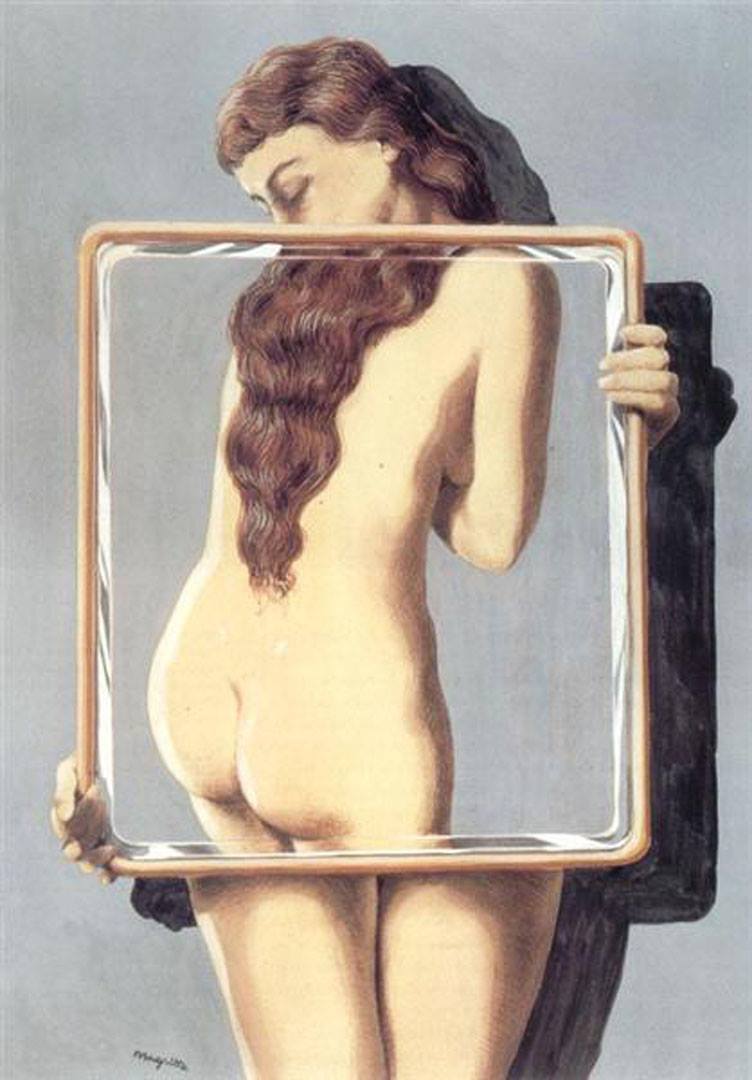 Besides, these dispersed mirror-drops do not allow the viewer to see the
figure completely, to observe the object in detail, understand and
comprehend it. Drops interfere the process of looking, giving their
interpretation and taking the responsibility of conveying the image to the
viewer, because as an intermediator, they are not letting the viewer to
relate with the image directly. As a result, the depicted object receives
a status of alienated object where the viewer’s gaze can’t “possess” it.
Besides, these dispersed mirror-drops do not allow the viewer to see the
figure completely, to observe the object in detail, understand and
comprehend it. Drops interfere the process of looking, giving their
interpretation and taking the responsibility of conveying the image to the
viewer, because as an intermediator, they are not letting the viewer to
relate with the image directly. As a result, the depicted object receives
a status of alienated object where the viewer’s gaze can’t “possess” it.
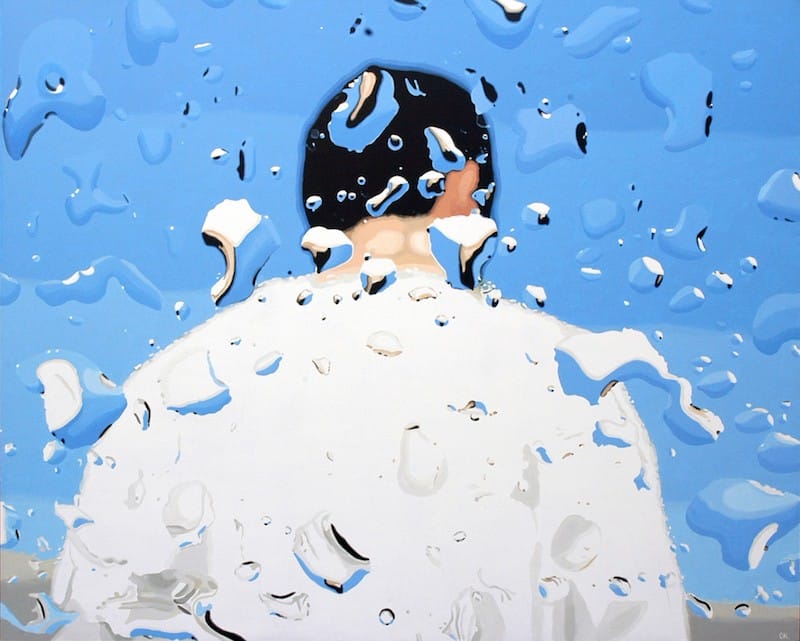 Here it is possible to have a typical comparison with the ideas of Lacan
that relate with the logic of the gaze, which he represents in Four Basic Ideas of Psychology seminar. According to Lacan subject never sees what it wants to see
or what in reality it is. Thus the seen is never desirable. Lacan brings
an interesting example, comparing the human’s logic of the gaze with the
animals’, who in order to protect and be safe from other animals’ gaze
hide themselves by merging with the environment. He believes that human
creatures are also used to manage the masks which they suggest to the gaze
of other subjects. Thus, the gaze can indicate the presence of others in
the same visual space.
Here it is possible to have a typical comparison with the ideas of Lacan
that relate with the logic of the gaze, which he represents in Four Basic Ideas of Psychology seminar. According to Lacan subject never sees what it wants to see
or what in reality it is. Thus the seen is never desirable. Lacan brings
an interesting example, comparing the human’s logic of the gaze with the
animals’, who in order to protect and be safe from other animals’ gaze
hide themselves by merging with the environment. He believes that human
creatures are also used to manage the masks which they suggest to the gaze
of other subjects. Thus, the gaze can indicate the presence of others in
the same visual space.
The same hidden function have drops in “Real Utopias”. They refract the gaze preventing it to reach to the target. The gaze runs, glides over the surface looking for free places to enter inside but in vain. And here, the fact that the depicted figure stands with its back to the viewer, also promotes such a notion and resists the moment of revelation by the gaze. Maybe the image also doesn’t want to be seen? Maybe it has acquired the veil indicated by Lacan?
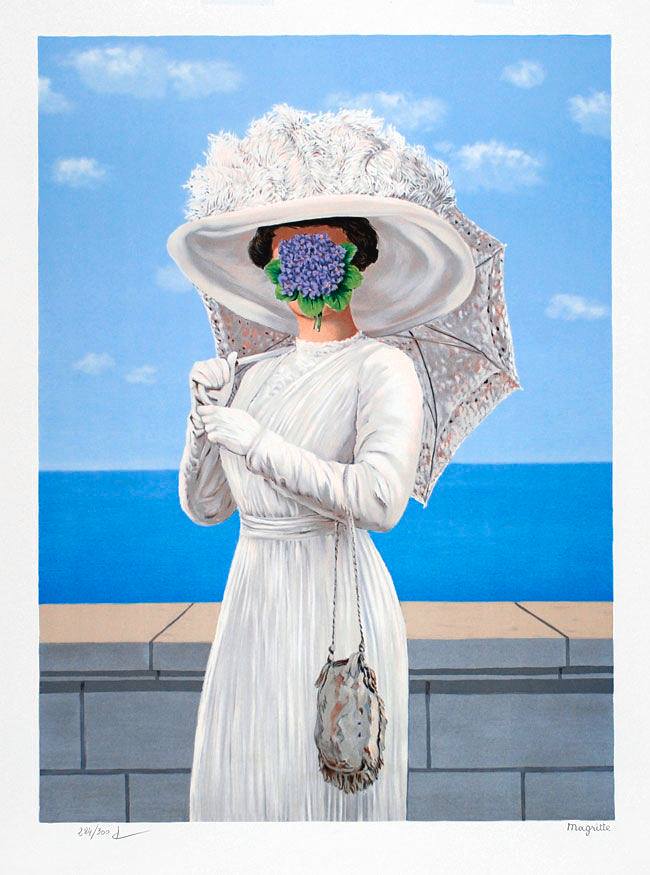 In terms of the use of these visual barriers (from mirror-drops and
their wrong reflection, to difficulties to overcome the painting’s
surface, all the way to the figure standing with its back to the viewer)
it’s better to make a comparison with another work of Magritte, the series
of “Big war”. The main theme of this series is “hidden visibility”, where
some fragments and basically, the most important ones, like a figure’s
face is intentionally closed by another object, for example, by a bunch of
flowers, an apple or a bird. In his letter to his friend Patrick
Waldberg Magritte mentioned about these works writing that the most
interesting thing in this world is the presence of the visible visibility
and the hidden visibility which suddenly intrude to our consciousness and
are inseparable from each other in nature. Every visibility has another
visibility behind it. Magritte claimed that his paintings just directly
represent such situations, when the action happens between representation
of visible phenomenon and the hidden object behind that visibility. That
is the action of revelation, which Magritte compares with struggle.
In terms of the use of these visual barriers (from mirror-drops and
their wrong reflection, to difficulties to overcome the painting’s
surface, all the way to the figure standing with its back to the viewer)
it’s better to make a comparison with another work of Magritte, the series
of “Big war”. The main theme of this series is “hidden visibility”, where
some fragments and basically, the most important ones, like a figure’s
face is intentionally closed by another object, for example, by a bunch of
flowers, an apple or a bird. In his letter to his friend Patrick
Waldberg Magritte mentioned about these works writing that the most
interesting thing in this world is the presence of the visible visibility
and the hidden visibility which suddenly intrude to our consciousness and
are inseparable from each other in nature. Every visibility has another
visibility behind it. Magritte claimed that his paintings just directly
represent such situations, when the action happens between representation
of visible phenomenon and the hidden object behind that visibility. That
is the action of revelation, which Magritte compares with struggle.
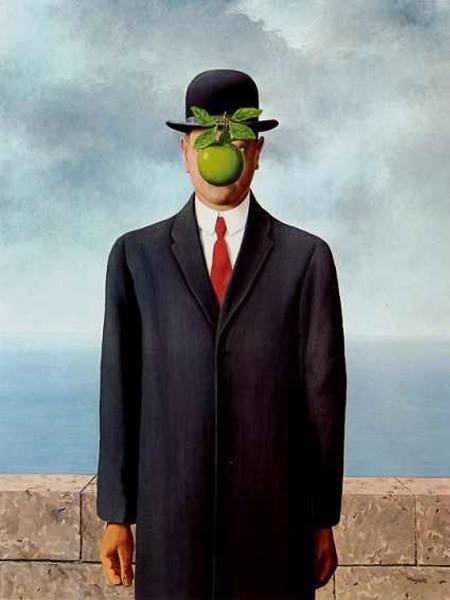 This fight for revealing the gaze existed in Ohanyan’s “Real Utopias”
also. The viewer struggles to see the image till the end, reveal what is
not visible for the gaze, but it is obvious that it exists. At first
glance, and, especially from the distance, these seemingly simple
paintings forced the viewer to look at them for a long time, to try to go
deeper, make efforts to reach the most essential part; the figure,
which, however, stands in front of the viewer with its whole length.
This fight for revealing the gaze existed in Ohanyan’s “Real Utopias”
also. The viewer struggles to see the image till the end, reveal what is
not visible for the gaze, but it is obvious that it exists. At first
glance, and, especially from the distance, these seemingly simple
paintings forced the viewer to look at them for a long time, to try to go
deeper, make efforts to reach the most essential part; the figure,
which, however, stands in front of the viewer with its whole length.
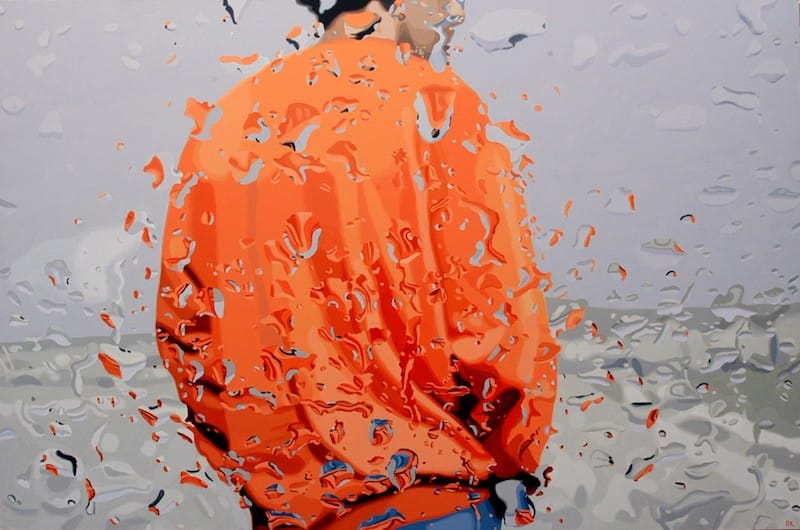 Another important aspect of the problem of reflection is the window. It
creates the interaction of real and unreal it expresses the reflection of
each other, one inside the other.
Another important aspect of the problem of reflection is the window. It
creates the interaction of real and unreal it expresses the reflection of
each other, one inside the other.
Finally, let’s mention, that all these drops are on the window, and the figure is on the other side of it. Vardan Azatyan speaks about this transparent glass in his text, too. In fact, the figure is reflected not only in water drops but also in the glass of a window and it creates a double wrong reflection. In other words, in the painting the reality is completely inaccessible for the eye, instead of the reality the gaze faces another barrier, the window. The figure, which is already in the last background, is seen only through the reflection of the water drops and through the empty spaces between them. During the reverse action, which means during the process of viewer’s perception, it faces another “barrier”, which stands between the viewer (and even the artist himself) and the image. It’s impossible that after passing through such barriers the figure could hold its completeness, be undestroyed, not turned into pieces, not become the reflection of its own image, which may have the meaning of a psychological split as well.
So, “mirror-drops”, hidden from our gaze, and the window, interfering the viewers gaze, create the image, which is simultaneouslyin the border of imaginative and real and which can only be called “Real Utopia”.
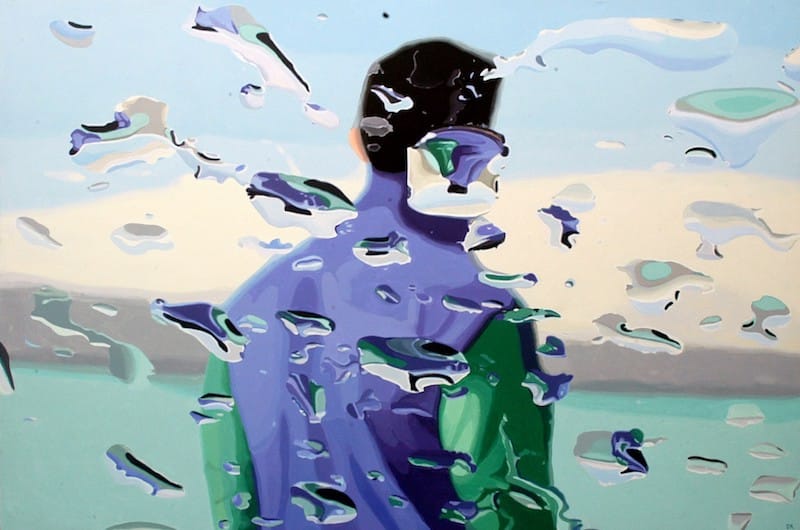
Vardan Azatyan’s text and my article were published in Actual Art magazine, 2006.
Online version of this article in Armenian language could be found also in Revisor online art magazine www.revisor.am.
Keith Moxey, The Practice of Theory. Poststructuralism, Cultural Politics, and Art History. Cornell University Press. Ithaca and London, 1994, 53.